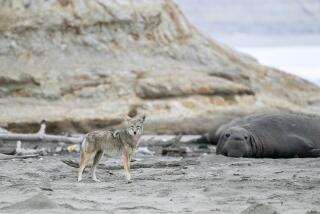Growth in Maine’s Seal Population Called Puzzling
- Share via
TENANTS HARBOR, Me. — When a hooded seal nearly the size of a pickup truck wandered onto a highway in this coastal community, it did more than tie up traffic.
The animal’s appearance dramatized the recent growth of Maine’s seal population and the arrival of species not normally found on the state’s rocky shores. The population of Harbor seals in Maine has doubled in the past decade to more than 28,000, but marine mammal experts admit they are not sure why the animals are doing so well.
“What’s exciting or disturbing, depending on who you talk to, is that we’ve [also] seen more Gray seals, and once in a while we’re seeing a few ‘ice’ seals,” said James Gilbert, a University of Maine wildlife professor.
Gray seals and ice seals, whose varieties include harp, hooded and ringed seals, have traditionally stayed closer to the Arctic, making their homes in Newfoundland and around the Gulf of St. Lawrence.
Experts say the population of Harbor seals is not only increasing; females are also having pups at an earlier age, increasing the number of young seals in the herd.
“This is an indication of a very healthy population,” Gilbert said.
Maine, with its rocky coast and numerous coastal islands, provides an ideal home for seals, which spend much of their time in the water but rest and breed on ledges. Much of the speculation about the cause of the seals’ success centers on the collapse of stocks of groundfish such as cod, haddock and flounder because of overfishing in the North Atlantic.
Depletion of the groundfish has allowed the stocks of other “non-commercial” fish species to multiply and provided the seals with a food supply they did not have to compete for with fishermen.
“They’re very opportunistic,” Gilbert said. “They’re just as smart as dogs or coyotes.”
Others believe Canadian seals that were more dependent on groundfish have been forced south by a lack of food, but officials there contend the herds are doing well.
“There is certainly no indication that they have left,” said Jean Hache, a senior adviser to the Department of Oceans and Fisheries in Ottawa.
Canada conducted its annual harvest of seal pups in April and is hoping for increased exports of pelts despite protests from international animal rights groups. Federal law makes it illegal to kill seals in the United States and the animals’ protected status has angered Maine’s aquaculture industry, which blames them for millions of dollars in losses each year.
“They won’t give us the right to protect our equipment and our product and they won’t recompense us if we do lose it,” complained Frank Ayers, who raises salmon in pens in the waters off Eastport.
Conservationists contend that “fish farms” such as Ayers’ can be protected by non-lethal means. A federal task force is studying the issue.
Gilbert doubts the number of seals has reached historic highs yet, since this period of population growth follows several decades in which the size of the herd had declined.
Wildlife experts also acknowledge they do not know how long the seal herds will continue to grow.
“At this stage in the game, we’ve not seen any slowing down in the rate of increase in the population size so, we don’t know where that plateau is,” Gilbert said.
As the seal population grows, officials admit that conflicts between the animals and their human neighbors will likely increase as well.
“More and more ledges are going to be occupied by seals in the summertime and we’ll have more potential for conflict with the fisheries and more disturbances by boat people looking at the seals,” Gilbert said.
More to Read
Sign up for Essential California
The most important California stories and recommendations in your inbox every morning.
You may occasionally receive promotional content from the Los Angeles Times.













